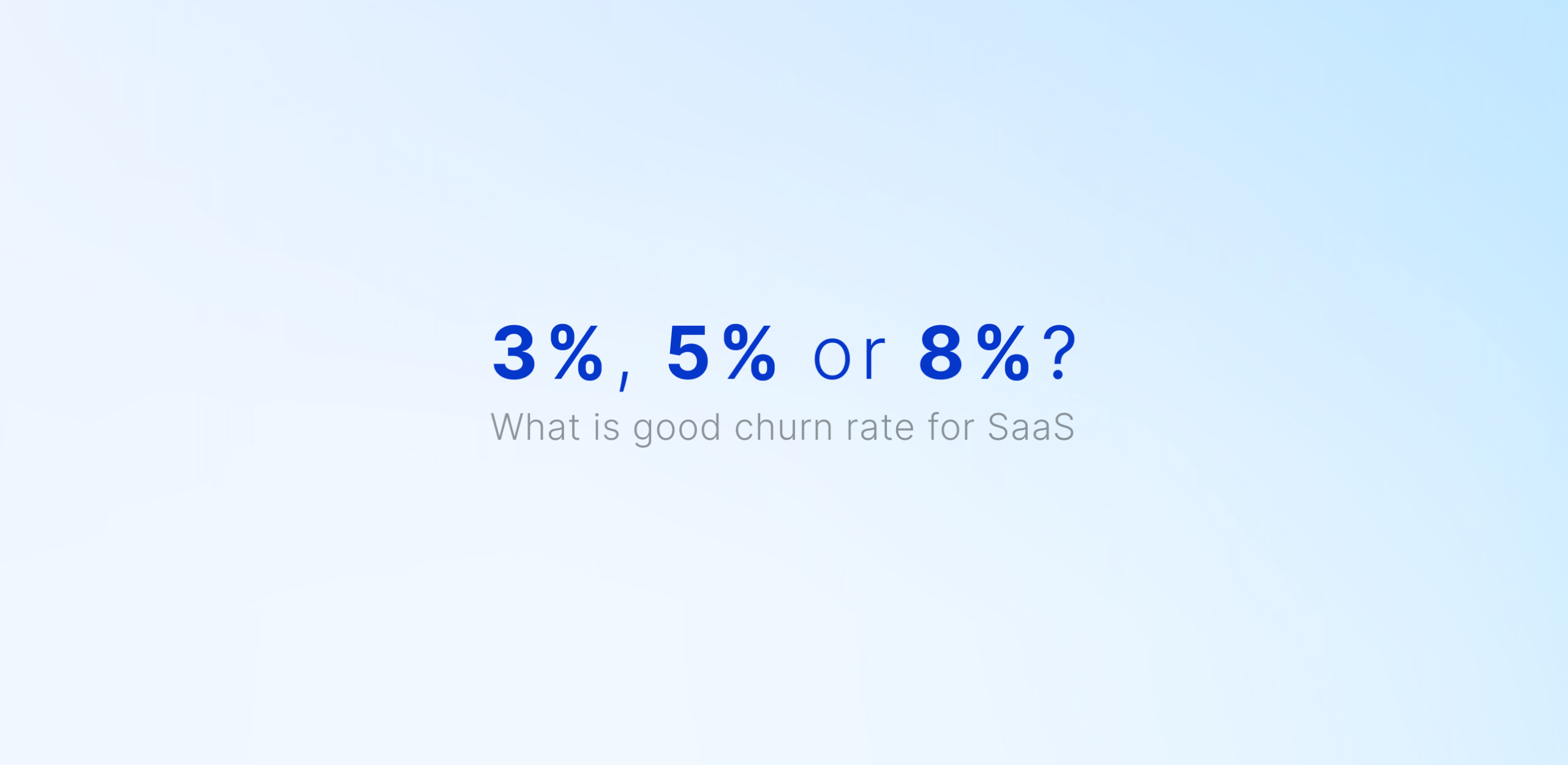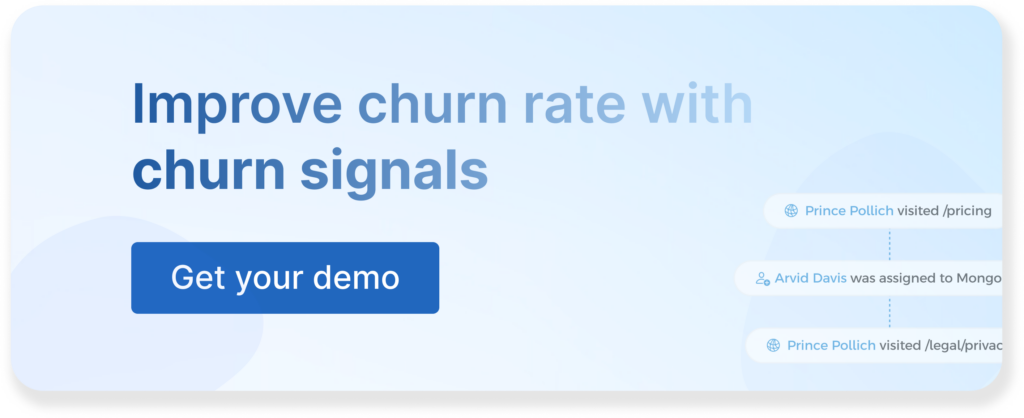Churn occurs when a customer stops paying for your product or service. It is one of the most prominent risks, especially for subscription-based businesses, and it always raises new questions.
If we are unable to detect how many of our customers are leaving, we cannot understand why they are leaving or know where to make improvements. We should always be aware of our churn rate and strive to keep it as low as possible.
What is Churn Rate?
Churn rate is the metric that shows you the percentage of your customers who stop paying you among all your customers. It is a crucial indicator of customer satisfaction and the sustainability of your business model.
Why It is Important to Track?
Tracking churn rate is important because it reveals a clear view of how satisfied your customers are. If a long volume of customers are leaving, it might be a sign that something’s wrong — maybe there’s a problem with the product, it’s priced too high, or customer service could be better. So, it is
How to Calculate Churn Rate?
To calculate the churn rate, divide the number of customers you lost during a certain time period by the number of customers you had at the beginning of that period. Multiply the result by 100 to get the percentage. Here’re the formulas for monthly and annual calculations:
Calculating Monthly Churn Rate
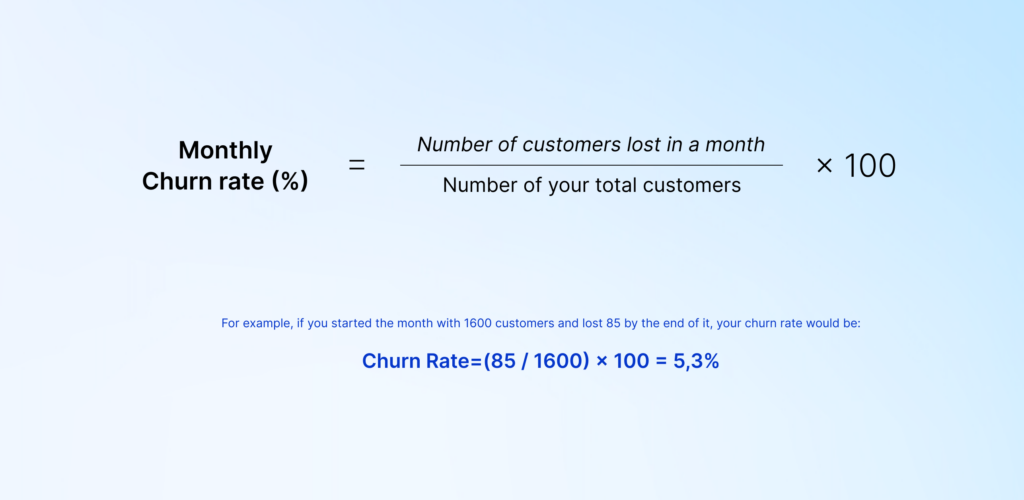
Churn rate (%) = (Number of customers lost in a month / Number of your total customers) × 100
Or you can also name it as:
Churn Rate (%)=(Number of customers at the beginning of the month – Number of customers at the end of the month / Number of customers at the beginning of the month) × 100
For example, if you started the month with 100 customers and lost 5 by the end of it, your churn rate would be:
Churn Rate=(5 / 100) × 100 = 5%
Calculating Annual Churn Rate
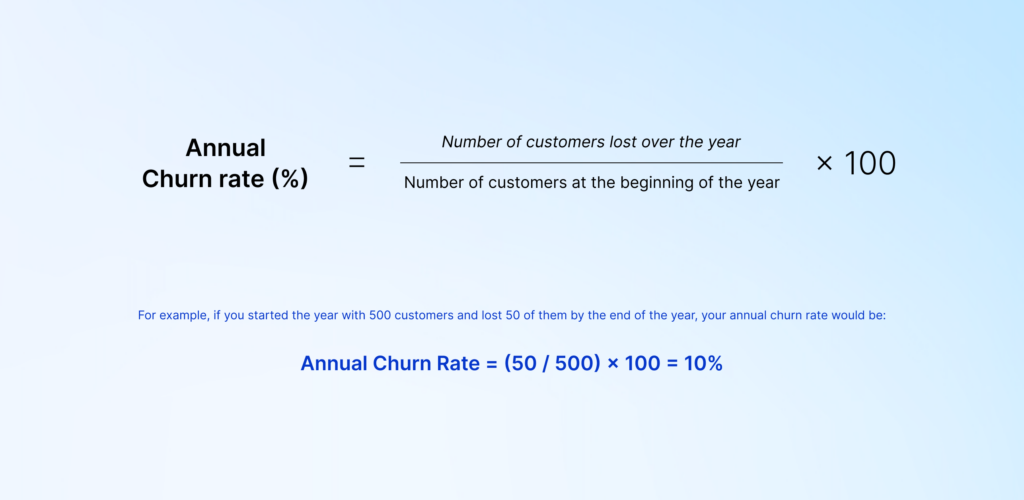
Annual Churn Rate (%) = (Number of customers lost over the year / Number of customers at the beginning of the year) × 100
For example, if you started the year with 500 customers and lost 50 of them by the end of the year, your annual churn rate would be:
Annual Churn Rate = (50 / 500) × 100 = 10%
What is the Good Churn Rate for Your SaaS?
The best churn rate varies based on the maturity and scope of a company. Generally, the lower the churn rate, the better, as it indicates stronger customer retention and satisfaction. However, there are average rates that can serve as benchmarks for different types of companies.
According to Forbes: The ideal churn rate should be between 5% to 7% for mature and established SaaS companies, annually, with a monthly churn of less than 1%. On the other hand, early-stage startups or small and medium-sized businesses (SMBs) typically see higher churn rates of 10% to 15% annually due to ongoing product improvements and market adjustments.
According to the KBCM Technology Group Private Company SaaS Survey in 2023, which surveyed 150 private SaaS companies, suggests that to achieve sustainable growth, SaaS companies should aim for an annual churn rate of no more than 8%, whether measuring dollar churn or customer churn.
Woopra highlights that the average monthly churn rate for a SaaS company ranges from 3% to 8%, while the average annual churn rate lies between 32% and 50%. These figures underscore the challenges faced by SaaS businesses in retaining long-term customer commitment.
According to Paddle, the average churn rate in SaaS is around 5%, with a “good” churn rate considered to be 3% or less. However, they emphasize that churn rates vary significantly across different businesses and industries. There is no one-size-fits-all “average” churn rate, and targets for churn can vary widely.
Challenges in Reporting Good Churn Rates
The lack of a standardised B2B subscription reporting method for churn and other metrics makes comparisons between companies and industries difficult. Some companies report revenue churn, while others focus solely on customer or user churn, without always separating between annual and monthly figures. This inconsistency makes it difficult to establish a universal benchmark for churn rates.
The Churn Rate is Just an Indicator: 5 Tips to Improve It
Churn rate is just an indicator, signaling deeper issues within your company that need attention. It’s important to take steps to address these issues before your churn rate worsens because they are directly related to your product and customer interactions. Improving churn can become much more manageable with the right strategies in place, such as:
1. Tracking churn signals/events
By monitoring churn trends and signals, such as long inactivity, uninstallation of features, or external indicators like a company downsizing or department layoffs, you can predict and address churn before it occurs. A churn prediction model is essential for identifying these early warning signs.
Implement churn prediction model to identify potential causes of customer leaving you before they happen. These models can analyze patterns that lead to churn.
For example, with UserMotion, you can stay ahead of churn by detecting early warning signals that might indicate a customer is at risk of leaving. UserMotion can alert you to crucial churn indicators such as:
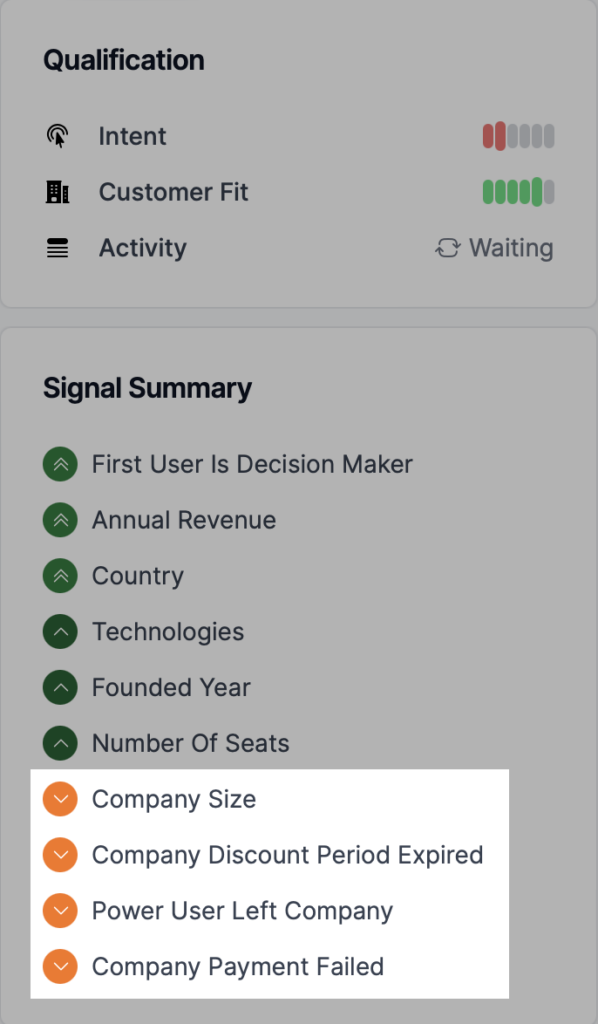
- A significant user, who is a decision-maker, has stopped using the service or has left the company.
- The company has reached the end of a discount period, which may increase the risk of churn due to price sensitivity.
- There’s been a failed payment, which could indicate financial issues or dissatisfaction with the service.
- Changes in the company size might reflect scaling down operations, potentially reducing the need for your service.
By integrating UserMotion’s predictive analytics, you can address these issues proactively. For instance, if UserMotion notes that a power user has left the client company, you can reach out to understand the new decision-makers’ needs and reaffirm the value of your service. Or, if there’s a failed payment, immediate communication can help resolve any issues before they lead to cancellation.
2. Improving the features of your product regularly
Regularly collecting customer feedback on product features and overall satisfaction helps you understand and improve the customer experience.
This ongoing dialogue can guide product enhancements that align more closely with user needs.
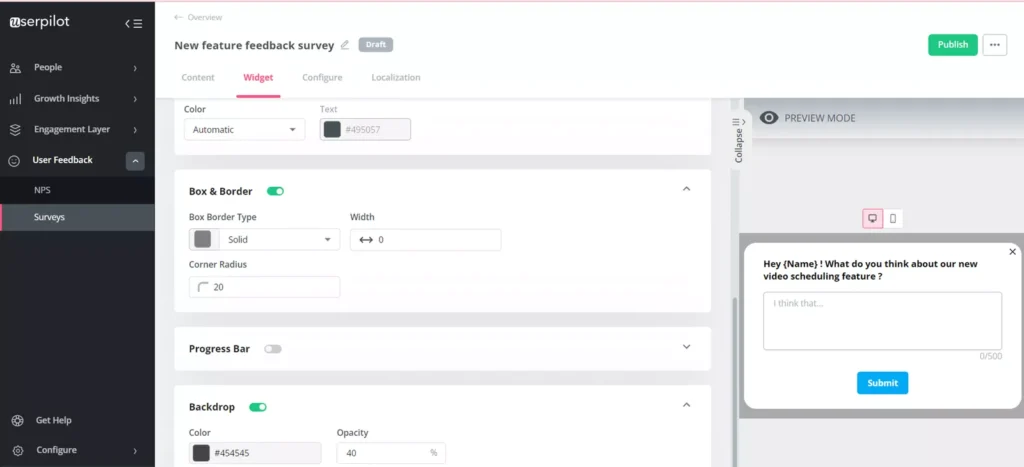
For example, Userpilot‘s feature feedback surveys help you send personalized surveys to understand if your features are loved by your customers.
3. Active and engaging customer success team
A strong customer success team is everything in churn prevention. Regular interactions, such as surveys, meetings, and creating connections, allow the CS team to maintain direct relationships with customers. This direct line can be crucial for quickly addressing issues that may lead to churn.
Tools like Gainsight or UserMotion empowers CS teams to track customer health scores, usage data, and interaction history. These tools help CS teams to engage with customers more effectively.
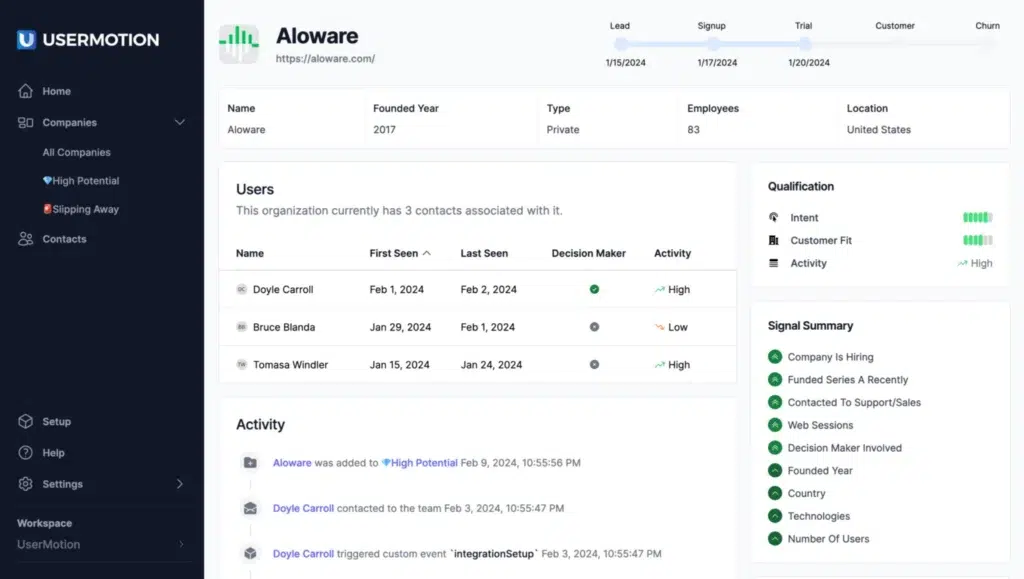
For example, UserMotion could enable a customer success team to automate health checks and use data-driven insights to prioritize outreach to customers who show signs of risk, such as decreased usage or negative feedback.
A CS team could then proactively schedule meetings or check-ins to address any concerns and reinforce the value of the service.
4. Bettering product-market fit
Staying informed about market trends is critical. Your product should evolve alongside the market to meet changing requirements and preferences. Regular market research helps identify opportunities for your product to better satisfy market demands.
Market intelligence platforms such as Crunchbase or CB Insights provide data on industry trends, competitor movements, and emerging technologies. These insights help companies to innovate and align their offerings with market needs.
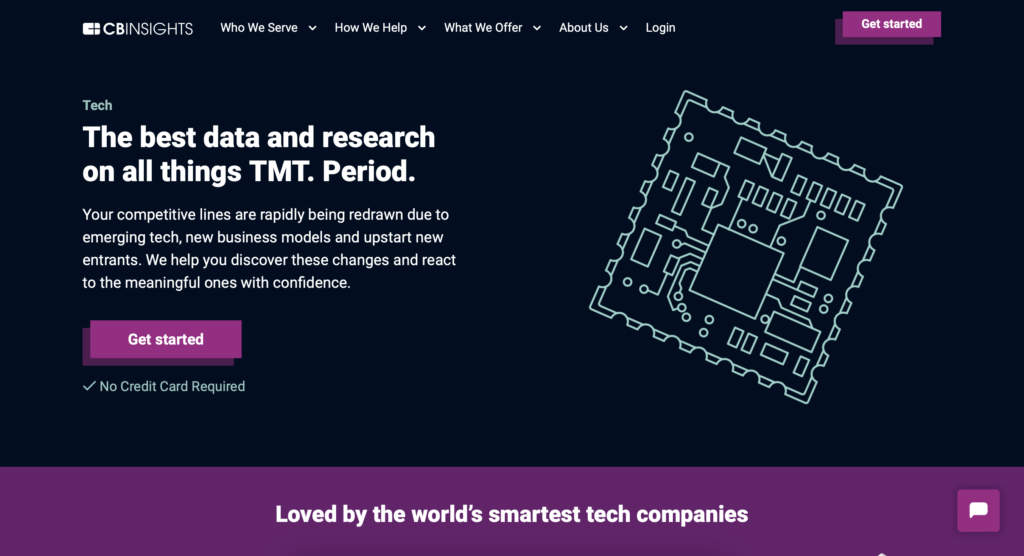
For example, CB Insights could be used to track emerging trends within a company’s sector, allowing them to adjust their product development roadmap to stay ahead of the curve.
This might involve adding new features that address untapped market needs or refining existing ones to keep pace with competitive offerings.
5. Understanding customer needs deeply
Each customer has unique needs and preferences. Understanding and addressing these individual needs helps provide personalized experiences that significantly enhance customer satisfaction and loyalty.
Go beyond surface-level interactions by deeply understanding your customers’ business goals, challenges, and feedback.
Key Takeaways
- Churn is a critical risk for subscription businesses, signaling a need for action.
- Churn rate, showing customer loss percentage, is vital for assessing satisfaction and sustainability.
- A proactive approach, using tools like UserMotion, can predict and mitigate churn.
- Regular product improvement based on customer feedback is key.
- A dedicated customer success team can significantly reduce churn risks.
- Understanding and adapting to market trends ensures better product-market fit.

